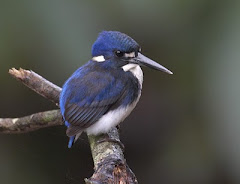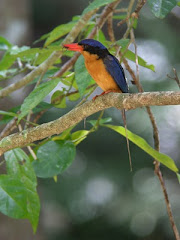May is the beginning of the 'winter' months in Daintree - cooler nights and misty mornings, followed by beautiful sunny days with temperatures in the mid-20's.
In the cooler nights of late, owls have been calling. Around Barrett Creek the (lesser) Sooty Owl has been calling each night and in the town of Daintree, early morning calls of the Barking Owl have been common.
The Barking Owl, a small Ninox owl, often feeds on small bats which are swooping for insects under the street lights of town. These in turn are feeding on insects drawn to the light. On the ground, under the lights, are bugs, beetles and unfortunately, cane toads.
Last night a pair of Barking Owls called to each other incessantly for an hour or so - quite delightful!
The other favourite with birders is the Rufous Owl - a large (up to 55 cm) owl which swoops with deadly, but silent, precision on roosting birds or even bandicoots on the ground. The garden at Red Mill House in Daintree Village is often the hunting grounds of the Rufous Owl and many a birder has been called out from dinner to watch the spectacle of the Rufous Owl feeding in the garden.
Wednesday, May 25, 2011
Sunday, April 17, 2011
Woodswallows
One of the great things about Daintree is that it is a mixed, integrated community with a healthy mix of agriculture and tourism driving the local economy. We don't always agree on everything, but we have so much in common by just living in this great part of the world.
We go birdwatching most days and are continually fascinated by new and interesting avian treats. Others, not birders, are also fascinated by the same wonderful things. Below are two photos taken by a local farmer of White-breasted Woodswallows nesting in the top of a fence-post on their farm. How they survive in such exposed conditions is a wonder. The last photo is of a pair of adults.
Of the six species of Australian woodswallows, this is the only one here in the coastal lowlands of Tropical North Queensland. Strong flyers, they can soar for lengthy periods, hawking on insects. They are extremely sociable and you can often see up to 20 birds clustered in together on power lines or fences. A particularly sweet little bird.
We go birdwatching most days and are continually fascinated by new and interesting avian treats. Others, not birders, are also fascinated by the same wonderful things. Below are two photos taken by a local farmer of White-breasted Woodswallows nesting in the top of a fence-post on their farm. How they survive in such exposed conditions is a wonder. The last photo is of a pair of adults.
Of the six species of Australian woodswallows, this is the only one here in the coastal lowlands of Tropical North Queensland. Strong flyers, they can soar for lengthy periods, hawking on insects. They are extremely sociable and you can often see up to 20 birds clustered in together on power lines or fences. A particularly sweet little bird.
Saturday, March 5, 2011
The 'wet' season - best for birds!
Apologies for the delay in blogging. We had a month away visiting family and friends in Western Australia - fabulous birds in the south west corner and although we missed the Noisy Scrubbird, we saw many of the endemics of that part of the country. An extremely diverse area in plant life and habitats and well worth a visit.
February was the wettest on record in Daintree Village with 1640ml of rain, bringing the year's (2 months!) total to 2117ml by the end of the month. We endured Cyclone Yasi who, fortunately for us, crossed the coast south of Cairns, causing minimal damage here in Daintree. Red Mill House, particularly, fared well - it seems the small hill behind us protects us from the strongest winds. The house was built in the 1920s and is still standing in it's original state - great design and great location!
Back in Daintree, the weather has improved and visitors are coming. The 'wet' season is always best for birding, despite the sometimes-rainy conditions. The summer migrants are all still here, including the Buff-breasted Paradise Kingfisher. The Little Kingfisher and Azure Kingfisher are also more visible as the breeding season come to an end. Both have been seen on the pond at Red Mill House in recent days. Also in the garden is Australasian Koel, Double-eyed Fig-Parrot, Wompoo Fruit-Dove, Yellow Oriole and others. A short, late afternoon walk with guests along Stewart Creek Rd from Daintree Village was very productive with Channel-billed Cuckoo, Little Bronze Cuckoo and female Australian Koel, plus a range of birds foraging for insects in the afternoon sun - Grey Whistler, Spectacled Monarch, Leaden Flycatcher, Fairy Gerygone,
Graceful, Macleay's and Yellow-spotted Honeyeater, Mistletoebird, Olive-backed Sunbird, Spangled Drongo, and Varied Triller. Others, chasing fruit, included Brown-Cuckoo Dove, Figbird and Wompoo Fruit-Dove. A lovely walk and great introduction to the UK birders who had just arrived.
Sunday, January 23, 2011
January 2011
After a very wet year in 2010 ( 4.6 metres of rain), it has been a normal start to the year in the Wet Tropics and in Daintree. We would normally expect the 'wet season' to begin at this time of year and to date we have had over 400ml. Evenly spaced, so no flooding - unlike our less fortunate cousins in southern Qld. We seem to be blessed with stable weather patterns in this part of the world.
An excellent trip on the Daintree River for Red Mill House guests this morning with the highlight being the nesting Herons. Both Striated Heron and Nankeen Night-Heron are nesting. The Nankeen Night-Heron feeds at night, hunting for insects, crustaceans, fish and amphibians.
This morning's passengers were also treated to a pair of Great-billed Heron flying, displaying, calling and preening.
The Great-billed Heron is Australia's largest heron and has an enormous bill. It is found in Northern Australia, found in mangroves, tidal mudflats and lowland rivers. It can be found most of the year on the Daintree River and in Barratt Creek and Stewart Creek.
An excellent trip on the Daintree River for Red Mill House guests this morning with the highlight being the nesting Herons. Both Striated Heron and Nankeen Night-Heron are nesting. The Nankeen Night-Heron feeds at night, hunting for insects, crustaceans, fish and amphibians.
This morning's passengers were also treated to a pair of Great-billed Heron flying, displaying, calling and preening.
The Great-billed Heron is Australia's largest heron and has an enormous bill. It is found in Northern Australia, found in mangroves, tidal mudflats and lowland rivers. It can be found most of the year on the Daintree River and in Barratt Creek and Stewart Creek.
Subscribe to:
Comments (Atom)









